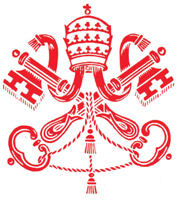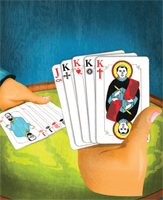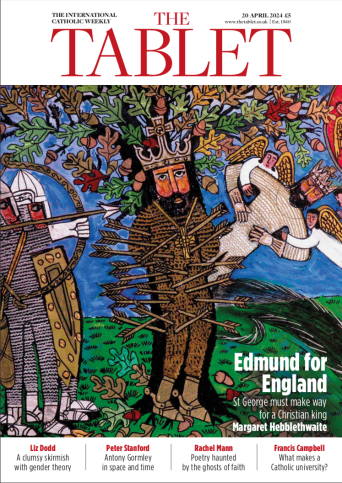The UN committee’s critique has refocused attention on the preparation of priests for the ministry. In the first of two articles, a priest-psychotherapist argues that the handling of the abuse crisis has been inhibited by a concentration on theology rather than an understanding of the human psyche
In the late 1960s, our theology schools were abuzz with the Second Vatican Council, but that had not yet impinged on confessional practice. Among other things, we had “mock confessions”, in which (in front of everyone else) the ordinands took turns at being confessor while our professor, the redoubtable Paul Brassell, took the role of the penitent.
Fr Brassell’s amazing command of accents and dialects, and the realism of the way he said things whether coming from man, woman or child, made the whole exercise both instructive and entertaining.
Catherine Pepinster’s recent column in The Tablet about certain shortcomings in confessional practice (4 January 2014) in matters relating to the sixth commandment raises some significant issues which bring us to the contemporary problems about sexual abuse and how it is responded to. I recall Paul Brassell’s emphasis that a very brief or vague mention of a sin could be deliberately used by a penitent to “slip by” a tired priest’s attention; and “broke the sixth commandment” could be used to euphemise various things up to and including rape. The confessor was supposed to make discreet enquiries in order to establish (in his mind, at least) whether the sin was mortal, so that he could tailor his advice, and the penance, accordingly.
It was a clear principle that every sin against the sixth was mortal, so there was no need to establish that: no doubt to the relief of some confessors. But there were strong warnings against prurient enquiries.
There was also a need to assess gravity or culpability, even within the principle that they were all mortal. Thus, if a sailor went to a prostitute in a foreign port, he was less culpable than if he had sex with, or especially seduced, teenage girls, or raped anyone. The most heinous sins were if a priest confessed to soliciting a penitent in the confessional, or to absolving a woman he had had sex with. Worst of all was soliciting with the promise of absolution.
We never could decide which was the “worst” aspect of these lapses. The abuse of the vulnerability of the woman was bad enough, and that was aggravated if the confessor had formed an opinion, in the light of what she had said, that she might be easy prey: that was depravity. But there was also the question of the sacrilege, or abuse of the sacrament: what might be called a theological sin. Was that worse than any abuse of a fellow human being? Not everyone thought so.
The view was that the theological sin had no consequence: once absolved, the sinner was completely reinstated. Whereas the abuse of the woman could have deep, far-reaching and long-lasting consequences. But that was never referred to in our classes; there was no notion that the priest-penitent in such a scenario had inflicted damage on someone, and had to try to repair it, at least by making sure she received the pastoral care she needed.
It may be worth adding here that very little attention was given in the classes to homosexual misdemeanours, not even to dimensions of seductive behaviour or intent; and there was nothing at all about sexual abuse of minors.
Across the way, in the canon law class, Theodore Davey observed drily that in canon law the penalties against priests for soliciting in the confessional etc. did not apply in the homosexual context (which did not make such things “not wrong”); when challenged he suggested that possibly canon law, like Queen Victoria, just did not believe that such things could happen.
It is easy to see how a culture of too much reticence (which might have suited some penitents, but also some priests who lacked confidence or skill) could have grown out of these dynamics, even with the best of intentions on the part of those who were instructing seminarians. For the penitent, especially a woman faced with a severe and phobic priest, there was the shame; for the confessor, there could be a hardly-acknowledged sense of being far out of his depth.
The training we got was probably not adequate, especially in the sphere of pastoral care, though I wonder what kind of preparation doctors and lawyers were then getting for dealing with similar situations. Society at the time was what it was; there was virtually no attention being paid to such matters as the sexual abuse of minors, and very little to the exploitation of women. Meanwhile, all psychological approaches (and everything by Freud in particular) were being viewed by the Church with the deepest suspicion that they were pernicious libertarian nonsense, and not worth studying.
In an attempt to explore some of these questions, especially how it could have happened that sexual abuse took so long to be identified as a crime against children, I published under a nom de plume an article with the title, “Sexual abuse: What happens now?” (The Month, February 1995). Nobody responded.
I was trying to assess the suggestion that, until not long before the time of the first outcry in the United States about sexual abuse by priests and cover-up by their superiors, it was commonly thought (even by the majority of psychologists) that sexual abuse did no particular harm to the victim. The evidence cited for this was the observation that they did not remember afterwards.
However, advances in the theory and practice of psychotherapy, especially for children, applied the concepts of unconscious processes, and of repression in particular, to prove beyond all doubt that children were deeply harmed by abuse of every kind (not just sexual). It was shown that lives were adversely affected even if the abuse was never recalled by the victims at all. It was also shown that abuse could be brought to mind by careful and respectful psychotherapy, and its ill effects on the person gradually neutralised.
Probably there were attitudes (never spelled out because they do not stand up to scrutiny) that considered that the children do not suffer any lasting harm, indeed some of them seemed to “want it”: the priest has sinned but that is mainly a theological sin against his priesthood, and once absolved it has no consequence.
Until such time, recently, as children began to be believed by social workers and psycho- therapists when they complained of being abused, and adults began to recall and identify experiences of being abused in childhood, these unexplored and unidentified attitudes were able to carry the day, at least in the short term. This might be some kind of explanation, though it is not an excuse, of how covering up in the Church went on for so long, and is still being defended in some quarters. The idea that the victim would need extensive help did not originate in the Catholic Church.
I was struck when reading in The Tablet (November 2010) some observations of Benedict XVI on responses to sexual abuse. At one point, in particular, Benedict says: “What does someone like that think when he goes to the altar? … How can someone then fall so far? We do not know.”
This is a remarkable detail in itself: it shows the humility of Benedict being able to admit he is baffled. With some colleagues, I began to wonder if this is the first time in history that a pope has publicly admitted that there is something he does not know. But it is apparent that, before and since Benedict’s question, there have been people who have offered answers.
Thus, some thoughts in my article of 1995 suggest: “[priests in question] … live lonely lives, very deprived emotionally, with few or no fulfilling relationships … and an element in the emotional make-up which nudges them towards this … relief for their unhappiness. This element … probably makes them unable to consider the harm they are doing to the fellow human beings who are their targets …”
I would not claim that these reflections are in any way definitive, but they point to a contrast. Benedict is taking a purely theological approach and he is finding no answer to his question. The answer lies in psychology in general, and in psychodynamics and attachment theory in particular.
The final catalyst for the writing of this article was Catherine Pepinster’s observation in her January column that “heresy trumped sex” (regarding the historical sexual misdemeanours in the community of Sant’Ambrogio, where it is now revealed that the Inquisition was considering trying the guilty parties for heresy). Her point seems, rather, that it was because the reports in question were put into a “heresy” file instead of a “naughty” file that they became non-confidential and therefore survived, but the upshot seems still that the original psychological (sexual) report was theologised.
Pepinster’s remark can thus be tweaked into “theology trumps psychology”, and in this form it sheds light on what we are looking at. There may still be a fondness in the Church (and not just in the Vatican) for converting, or reducing, every problem to a theological one – thus, sexual abusers and their victims, alike, are told to say more prayers while the question of a good quality of psychotherapy remains in limbo (I’m falling into the trap myself).
Granted that the Vatican is a human organisation, the inference is that it is not exempt from ordinary human dynamics: in this case, the desire (sometimes unconscious) to convert a problem from a sphere about which you know nothing, into a sphere that you think you know well, so that you can deal with it according to your own preconceived ideas. As we see, Benedict admits that (by following this path – my gloss) he finds no answer. But answers are there, ready for appraisal and application, in psychodynamics.
An immediate distinction is that it is not a priest, as an ordained and therefore consecrated person, who abuses: it is a man who happens to be a priest. Whether or not he takes illicit advantage of the fact that he is a priest in order to pursue his objectives, the basic given is that the abuser is a man.
The theological sin involved does not give an indication about a remedy, but then, as was discussed above, many would view it as having no consequence, needing no remedy but absolution with a firm purpose of amendment (and since victims have committed no sin, they do not come into the equation). Has this been the sticking point for so many in leadership who cannot accept that they did wrong in turning a blind eye or covering up?
On the other hand, the psychological pathway is largely unknown: I believe it is still the case that there is no psychology desk in the Vatican. Cases of clerical sexual abuse are dealt with by the Congregation for the Doctrine of the Faith, which is a theological commission. But if you add to that an attitude which says theology cannot ever be trumped by any other discipline, then you may be painting yourself into a corner, because you may be unable to hear things that would be to your own advantage, and you may not even know to whom to go for expert advice.
I am unable to shake off the feeling that much of what is being done so far in the matter of responses to sexual abuse may be suffering from a process of being theologised. Complex structures of safeguarding have been set up in many places, but possibly some of these arrangements have a lacuna in the area of psychology, and in the attitudes
of leaders, rather than that they explicitly theologise.
Safeguarding basically is prevention, and strictly speaking is quite separate from what happens after the watershed moment of a complaint being lodged; that is “response”. However, it appears that much of it consists of behavioural precepts – do this, don’t do that – perhaps because these are more easily policed; rather than a more psychological or interiorised approach, which would, for instance, study the psychology of the abuser or the etiology of abuse, or promote development of healthier attitudes and awareness, leading in turn to a reduction in incidents.
In some quarters (not everywhere), an attitude has emerged that would like to suppose that the work of prevention is more or less done, that any cases of abuse by people in the Church now are historical, and therefore that safeguarding officers have little to do. Therefore, since they are in post, and often feel sure they can help with “response”, they can be drafted into roles in the “response” sector, for which they have little or no preparation or training.
In the safeguarding context, “training” often means a three-day workshop, or less. There is no awareness of the sharp contrast between that attitude and the rigour, and long duration (four to six years is not uncommon), of the training of psychotherapists, which typically also includes ceaseless professional supervision and appraisal of their competence.
Therefore, it would appear that the “theologising” attitude I am trying to describe is to be seen in a church context that would be inclined to suppose, if not say: “We don’t need psychology, we have our theology”. This can flow over into such areas as the residential care into which priest-offenders are often placed.
Some of the units are run like monasteries or retreat houses, with hours every day in the chapel or at prayer, and a firm attitude that restoration of the priest to a full and devout prayer life (such as no healthy priest is ever able to keep up after ordination) is a key part of rehabilitation. Meanwhile, in many cases the psychodynamic elements of their programme (such as group therapy) are conducted by undertrained workers.
Perhaps a more telling example of theologising the process lies in the fact, still quite widespread, that priest-offenders are herded together into all-priest facilities (because they are priests) rather than put into a mixed facility with various others (because they are men), for the sake of protecting the image of the Church and even of protecting the priest in question from the “real life” of a mixed facility.
Such practices in treatment options can slide into collusion with the priest-offender, not to make his life too difficult, but to keep him in a comfortable retreat-house atmosphere: and this despite the reality that such clerical ghettoes have led to some very untoward incidents in the past (usually linked to the use of undertrained staff). This theologising attitude has still to acknowledge that the sacraments do not carry medicinal or psychotherapeutic qualities.
* Fr Jim Christie SJ has been working as a psychotherapist for 35 years and is based in Glasgow. He can be contacted at jimchristie@garnethillcentre.org.uk
Next week, he explores the long-term changes in approaches to root out and deal with child sex abuse in the Church.





 Loading ...
Loading ...
What do you think?
You can post as a subscriber user...
User Comments (1)
Jim Christie you mention that the person is a man who is a priest but you must also include a woman who is a nun as the nuns were at the forefront of abuse of children here in Australia.
Also you mention publishing a piece on abuse using a non de plume and receiving no response. This raises many questions about your audience and their disconnect from reality perhaps (if they were religious).
You also set out the training of priests in Confession and it shows a lack of consideration of the power play at work in a Confessional setting.
So many abusers used this setting to groom and subdue their victims. Surely you realise how fraught with danger is this setting. It is one of the reasons never to allow children to be subjected to it.
Jim you have much to offer the Church but perhaps the real contribution has been the revelations of how you were trained as experts who were powerful and authorative representatives of an institution promoting trust and delivering much evil.
There is a current delusion that the Clerical people can make the laity believe they and their children are safe from abuse. Only a complete and healthy mistrust of people in authority will deliver this, especially a mistrust of Clerial and Religious people.